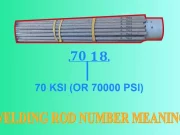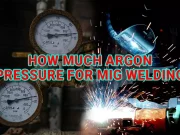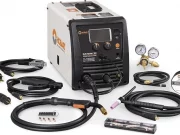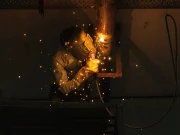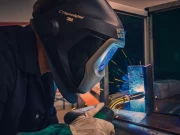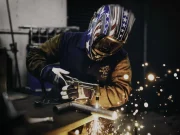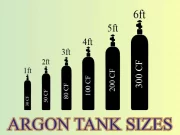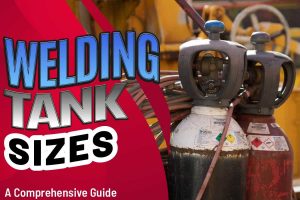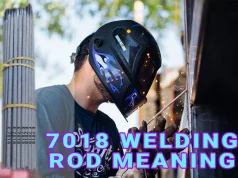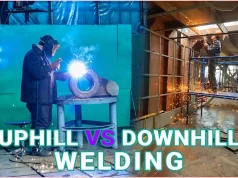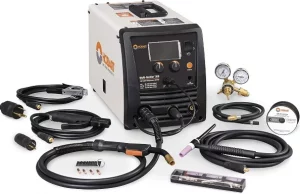Welding tank sizes is one of the hottest topics as far as welding is concerned. It’s disheartening for one’s welding gas to finish halfway into a project.
Diverse welding gas sizes exist. And choosing one that can hold enough gas to complete your welding project is what’s most paramount.
This article is a complete guide dedicated to welding gas cylinder sizes. After reading, you should be able to make an informed decision on which cylinder size is ideal for you.
Are you ready? Okay, let’s dive in.
Argon Gas Cylinder Welding Tank Sizes
Without much ado, let’s unravel the popular Argon gas cylinder tank sizes. These are ideal for MIG and TIG welding. Here’s the table below for easy understanding.
| Tank size
CF (Cubic Feet) |
Tank Size Name | Tank Capacity
CF (Cubic Feet) |
Tank Height
(Inches) |
Tank Diameter
(Inches) |
Tank’s Approximate Weight
(Pounds) |
|
| 1. | 20 | R | 21cf | 17 | 5 | 17 |
| 2. | 40 | RR | 44cf | 24 | 7 | 25 |
| 3. | 60 | Q1 | 65cf | 21 | 7 | 29 |
| 4. | 80 | Q | 83cf | 32 | 7 | 47 |
| 5. | 125 or 150 | S* | 125cf or 155cf | 46 or 50 | 7.5 | 61 or 70 |
| 6. | 250 | K | 251cf | 51 | 8.5 | 133 |
| 7. | 330 | T | 335cf | 55 | 9.2 | 143 |
So, here’s the table showing high-pressure welding tank sizes on the market. You can see that the dimensions are denoted with letters.
However, keep in mind that tank size with the letter “S” can vary. It all depends on the supplier and geographical location.
With that said, if you’re buying an “S” welding gas tank size, find out from the supplier the actual size you’re getting. Is the 125cf or the 155cf tank capacity? Ask questions.
How To Determine How Long Welding Tank Size Would Last
Imagine working on a welding project, and all of a sudden, you run out of welding gas. Nothing can be more devastating than this.
You want to finish the job and move on to other things. But here you are stuck.
Is there a way to determine how long welding gas will last? The answer is yes.
There’s a simple calculation that would help you determine how long your welding gas can carry you throughout a project. With the help of this calculation, you can evaluate gas welding time.
So, here’s how to calculate.
First off, gas welding time depends on a range of factors. One is the flow rate, which ranges from 10 to 40cfh (cubic feet hour).
A higher low rate under high wind is nothing terrible. Most welders find welding with 20cfh a bit more comfortable. And that’s what we’re going to be using in this calculation.
A Handy Tip: Pre-flow and post-flow determine how much gas you need for a project. If you’re working on a small project where you need to make frequent stops, you might end up using more gas than if you were working on a larger project.
Alright, let’s move over to the main calculation.
Gas welding time (Hour) = {welding tank volume (cf)} / {flow rate (cfh)}
Let’s assume welding tank volume = 60cf
Flow rate = 20cfh
Then, gas welding time = 60/20 = 3 hours.
This means if you’re using a 60 cubic feet tank under a 20cfh flow rate, the gas will last for 3 hours.
So, if your project would last much longer, it would be best to have a backup welding tank or get a bigger one.
Welding Tank Sizes And Use Time
| High Pressure Gas Tank Size
CF (Cubic Feet) |
Tank Size Name | Tank Capacity
CF (Cubic Feet) |
Use Time
(Rough Estimate ) (Hours) |
|
| 1. | 20 | R | 21cf | 1 to 1.5hours |
| 2. | 40 | RR | 44cf | 2 to 2.5hours |
| 3. | 60 | Q1 | 65cf | 3 to 4 hours |
| 4. | 80 | Q | 83cf | 4 to 5 hours |
| 5. | 125 or 150 | S* | 125cf or 155cf | 6.5 to 10 hours (Depending on the welding tank size) |
| 6. | 250 | K | 251cf | 12.5 to 16 hours |
| 7. | 330 | T | 335cf | 16.5 to 22 hours |
Acetylene Gas Welding Tank Sizes
We have discussed tank sizes for high-pressure gas. Now let’s discuss the one for acetylene gas. But before we dive into that, let’s look at what acetylene gas is.
Acetylene gas generates a flame that’s used for welding. It’s also highly flammable. The flame is produced when oxygen mixes with acetylene, making the gas ideal for multiple uses. The combination of oxygen and acetylene produces oxy-fuel, which you can use to cut and oxy-welding.
Now here’s a short description of acetylene. Acetylene is a colorless gas, which boasts a faint garlic-like smell.
However, acetylene is a low-pressure, non-toxic gas. It boasts a relatively low-pressure rating, and it’s volatile.
With acetylene’s volatility, the best option is to store the gas in a unique cylinder. Now let’s look at the acetylene gas cylinder sizes. You should be able to make an informed decision after going through the table below.
Acetylene Gas Cylinder Sizes
Here’s a table showing welding tank sizes for acetylene gas.
| Acetylene Tank name | Tank capacity (cubic feet) | Tank weight (Pounds) | Tank Height
(Inches) |
|
| 1. | MC | 10cf | 7 | 13 |
| 2. | B | 40cf | 22 | 9.5 |
| 3. | AX75 (WQ or perhaps, A60) | 60 to 75cf | 34 | 22.5 |
| 4. | SM (or probably WS) | 120 TO 140cf | 87 | 35.5 |
| 5. | MED | 200 to 250cf | 120 | 38 |
| 6. | LG310 | 300 to 340cf | 168 | 41 |
| 7. | LG420 | 420cf | 178 | 49 |
Propylene Gas Tank Size
Propylene is a prevalent gas in the welding industry. It’s an alternative to acetylene, used for welding, cutting, heating, and brazing.
This gas is also colorless and flammable. But then, compared to acetylene, propylene does boast a moderate BTU capacity.
One more thing; you can use acetylene at cold temperatures. Compared to propane, propylene also burns much hotter. And because it blends with oxygen, propylene is called a “pure” gas.
You’ll find varied propylene gas tank sizes out there. Let’s discuss them to have in-depth knowledge to decide when they need to buy one arises.
| Propylene Gas Tank Size (in cf) | Tank Height in Inches | Tank Diameter in Inches | Approximate Tank Weight in Pounds |
| 6 | 22 | 6 | 8 |
| 25.5 | 33 | 9 | 25.9 |
| 60 | 44 | 12 | 48 |
| 100 | 48 | 15 | 75 |
Propane Gas Tank Size
Propane might have some similarities with acetylene in that it’s flammable and combustible. But it’s not useful when it comes to gas welding.
When acetylene burns in oxygen, it forms a reducing zone, which helps clean the steel’s surface. Unfortunately, propane doesn’t have a reducing zone. Consequently, you cannot utilize it for gas welding.
Being highly combustible implies that propane gas can burn one’s flesh when it contacts the skin. But then again, it’s not used for welding. Instead, propane gas is used for brazing after the welding process ends.
A table showing the sizes of varied propane gas tanks. Read before making your decision.
| Tank Size in cubic feet (cf) | Tank Height (Inches) | Tank Diameter (Inches) | Tank Weight (Pounds) |
| 20 | 14 | 5 | 11 |
| 40 | 17 | 7 | 24 |
| 60 | 23 | 7 | 29 |
| 80 | 32 | 7 | 47 |
| 125 | 43 | 7 | 58 |
| 150 | 47 | 7 | 61 |
| 200 | 51 | 9 | 117 |
Things To Consider When Selecting Welding Tank Sizes
Whether you’re a DIYer or a professional welder, you need to decide on the ideal welding tank size for you.
A lot of things should come to mind when making these types of decisions. We discussed some of them in this section to guide you.
Budget size:
What’s your budget size? Here’s another question you should ask yourself before hitting the market for a welding tank. Welding tanks come at varied prices. And the higher the capacity, the more expensive the tanks would be.
Welding project sizes:
Are you a DIYer looking to fix smaller welding tasks at home, or a professional welder earning a living from welding? These two classes of welders would certainly have varied needs.
Generally, a professional welder needs to choose gas tanks with higher capacity than a DIYer. The reason is not farfetched. The professional would be doing a lot of welding than the DIYer.
Frequency of refill:
Has your gas ever finished halfway into a welding project? Only a handful of things feel more disappointing than this. So decide the refill frequency before splashing the cash on a gas cylinder.
Are you ready to take your gas to the dealer to refill often? Would that suit your tight schedule? These are the things to consider.
However, it won’t be cost-effective to spend long hours or money going to a dealer who lives far away to refill your gas often. There’s nothing logical about this.
So, if frequent refilling doesn’t suit your schedule, you need to settle for gas tanks with higher capacity.
Ease of transportation:
Don’t undermine this tip when buying a gas tank. It’s equally as important as other tips. Whether you’re a professional or DIYer, you should consider if you’ll be moving from one work site to another often.
If you’re going to moving your gas tank from place to place often, consider getting one that’s portable and easy to transport. The last thing anyone would want is to sustain an injury while working on a project.
Another thing is to consider your means of transportation. Is it well ventilated for your gas cylinder and you or others that would be sitting in the car? It would help if you considered these things.
Conclusion
We hope you now understand the welding tank sizes out there. This information should help you to make an informed decision when choosing gas cylinders.
Choosing the ideal tank size is a wise move. It would help you save time, energy and work on multiple projects comfortably.
So, choose the right tank size for you. And before doing so, consider the factors mentioned, as they can help you make the best choice.




